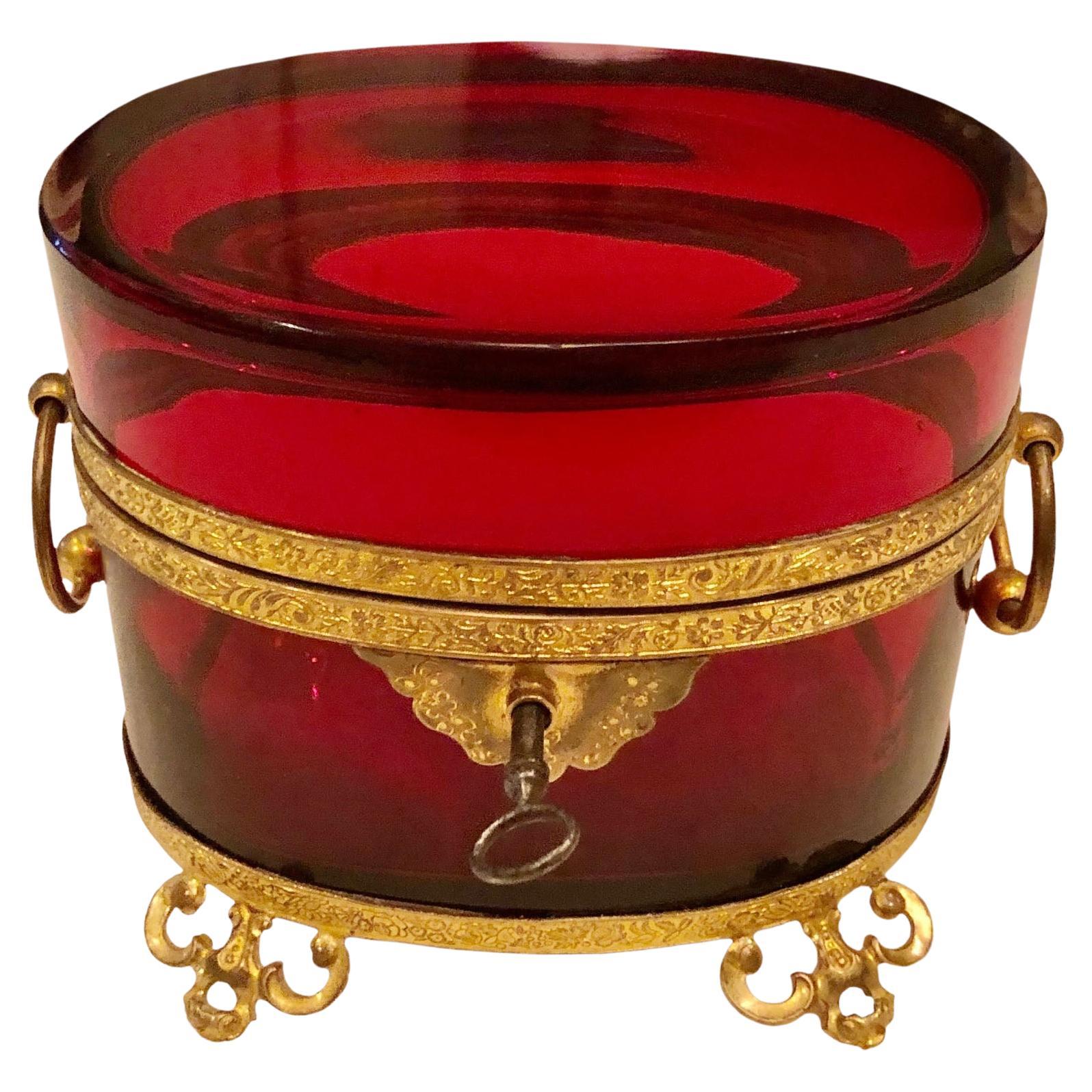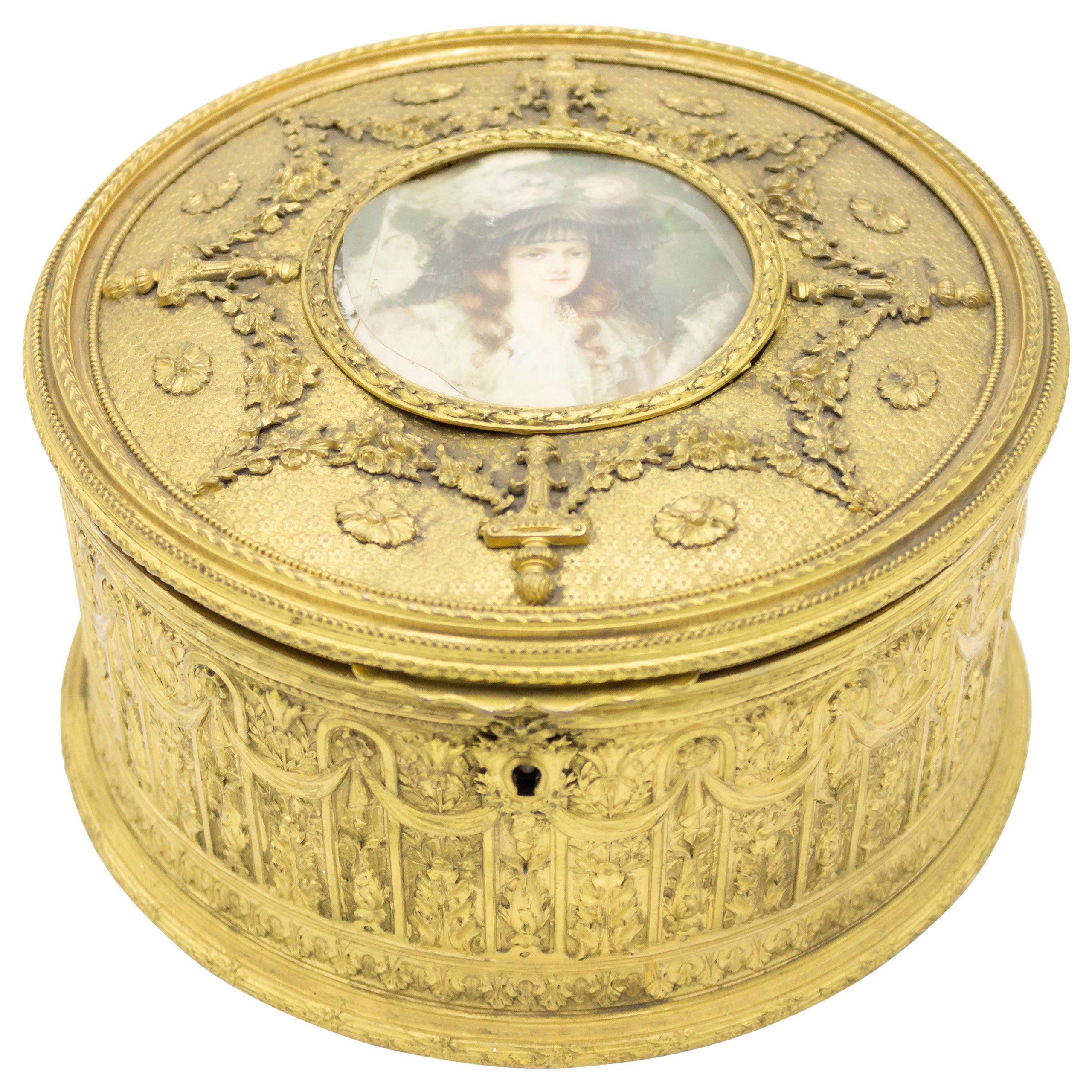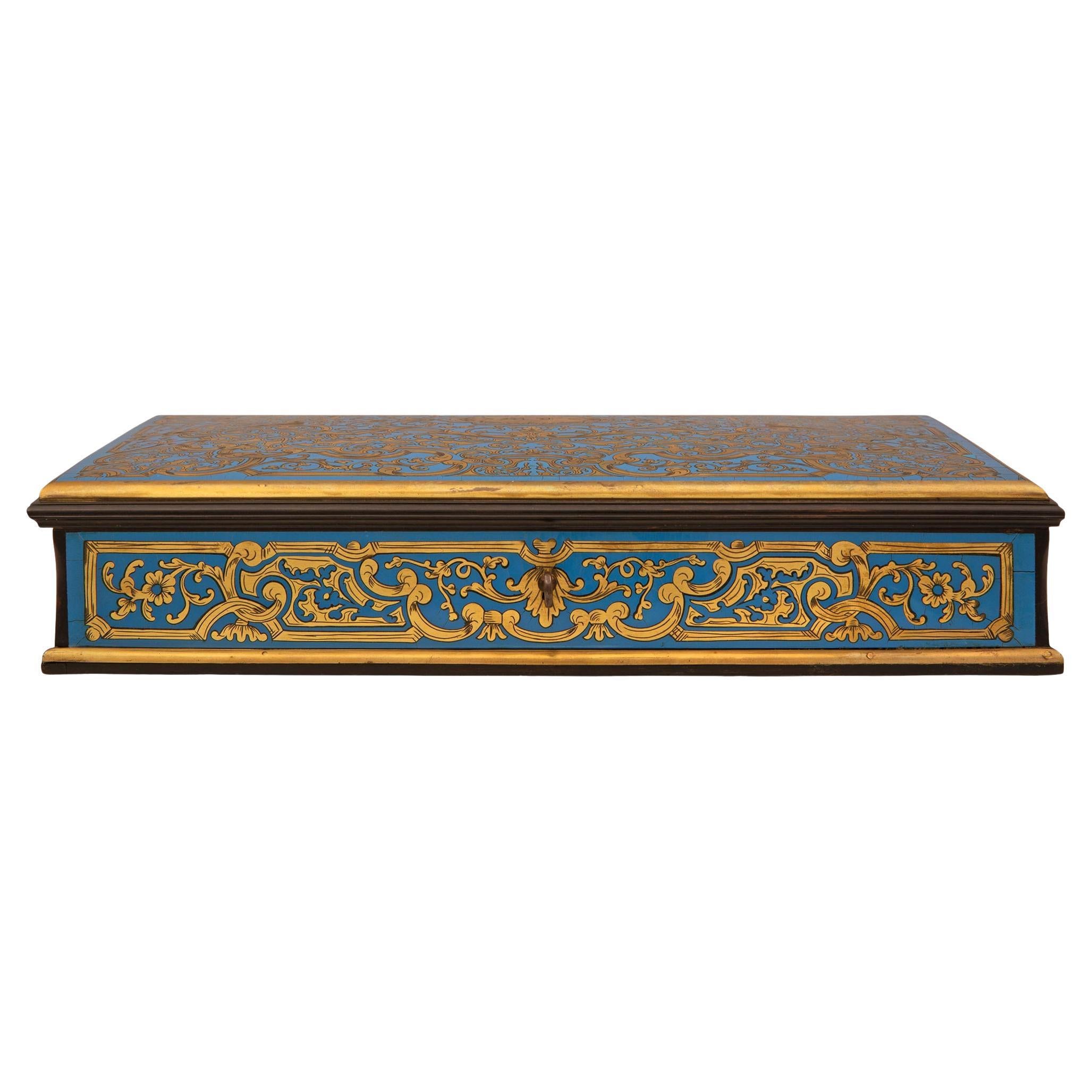Items Similar to Pietre Dure And Doré Bronze Box By Tahan
Want more images or videos?
Request additional images or videos from the seller
1 of 7
Pietre Dure And Doré Bronze Box By Tahan
About the Item
Crafted by Jean-Pierre-Alexandre Tahan, the esteemed cabinetmaker to Napoléon III, this jewelry box is a remarkable example of 19th-century European artistry. The box, shaped in doré bronze, displays a rocaille design characterized by golden, sinuous curves and ornate foliate details, each element chiseled and engraved with exceptional precision. Its aesthetic is further enhanced by vibrant pietre dure plaques, which showcase stunning butterflies set against a deep black backdrop, offering a striking contrast and vivid color. This piece, adorned with some of the world's rarest stones and meticulously set by highly skilled craftsmen, stands as a testament to the exemplary craftsmanship of its era.
Interior signed "TAHAN A PARIS"
19th century
9 3/4" wide x 7 1/8" deep x 4" high
- Creator:Jean-Pierre Tahan (Maker)
- Dimensions:Height: 5 in (12.7 cm)Width: 9.75 in (24.77 cm)Depth: 7.13 in (18.12 cm)
- Style:Empire (In the Style Of)
- Materials and Techniques:
- Place of Origin:
- Period:
- Date of Manufacture:19th century
- Condition:
- Seller Location:New Orleans, LA
- Reference Number:
About the Seller
5.0
Recognized Seller
These prestigious sellers are industry leaders and represent the highest echelon for item quality and design.
Established in 1912
1stDibs seller since 2010
93 sales on 1stDibs
Typical response time: 7 hours
- ShippingRetrieving quote...Ships From: New Orleans, LA
- Return PolicyA return for this item may be initiated within 7 days of delivery.
More From This SellerView All
- Micromosaic and Pietre Dure Grand Tour CasketLocated in New Orleans, LAThe time-honored decorative techniques of pietre dure and micromosaic are combined in this rare and exceptionally-crafted Grand Tour casket. Serving as a m...Category
Antique 19th Century European Greco Roman Decorative Boxes
MaterialsStone, Bronze
- Russian Malachite and Pietre Dure PlinthsLocated in New Orleans, LAThe exquisite art of pietre dure is at its absolute finest in this spectacular pair of Russian ormolu and malachite plinths. True works of art of the Restauration period, these plinths each feature a matching pietre dure mosaic crafted of the finest stones, all chosen to create a sense of depth and dimensionality in the final work. Depicting an onyx vase with tulips, roses, daffodils, magnolia and other flowers, these pietre dure panels are among the finest examples of this ancient art we have seen. The pietre dure is complemented by malachite panels of the highest quality, exhibiting exceptional depth through its extraordinary cellular structure. Malachite is one of Russia’s most precious stones, and its presence in these plinths indicates commission and ownership by an individual of considerable status. Mounted in an excellent stepped ormolu base, these plinths originally served as bases for vases or candelabra. The overall execution and appearance of these plinths is very characteristic of the taste associated with the immensely wealthy collector Nicolas Demidoff. As early as 1806, Demidoff had commissioned the Parisian goldsmith Henri August to supply a guéridon; in 1819, he ordered famed French bronzier Pierre-Philippe Thomire to supply mounts for a massive malachite vase (now in the Metropolitan Museum of Art, New York), as well as a console table with legs in the form of Nike. Other commissions included a table given as a gift to Grand Duke Leopoldo II of Florence, now in the Pitti Palace. Demidoff eventually settled in Florence in 1822 and became Russian minister to the Tuscan Court. Elevated to the rank of Count of San Donato by the Grand Duke, he built a magnificent villa at San Donato on the site of lands formerly owned by the Medici. The villa was later inherited by Anatole, his son, Prince of San Donato, and there are records which confirm transactions he had with the Opificio delle Pietre Dure. The 19th century proved to be the golden age of Russian malachite. The stone became a sign of prestige and a token of wealth, so much so that Russian papers of the time wrote: "To afford having a big piece wrought in malachite is synonymous to owning diamonds." Year after year the Russian (Romanov) treasury paid increasingly unreasonable prices to hoard the best malachite, much of which went into Romanov palaces and extravagant objets d'art. The Hermitage Museum possesses a collection of over two hundred examples of this “palatial” malachite...Category
Antique 19th Century Russian Pedestals
MaterialsMalachite, Ormolu
- Sèvres Porcelain And Bronze BoxLocated in New Orleans, LASeven resplendent Sèvres porcelain plaques surround this magnificent doré bronze box. The bright floral motif on the plaques perfectly matches the intr...Category
Antique 19th Century French Decorative Boxes
MaterialsBronze
- Grand Ducal Pietre Dure Console TablesBy Andrea BrustolonLocated in New Orleans, LAAmong the most beautiful examples of hardstone artistry that have ever entered our collection, these important Grand Ducal pietre dure console tables are in a class all their own. Their powerful architectural elegance, impressive size and rarity make them two of the finest hardstone masterpieces ever created and quite possibly the greatest pair of pietre dure tables in existence. With their naturalistically rendered flowers and birds, these tabletop panels showcase the particularly fine quality craftsmanship of the Grand Ducal workshops in Florence during the first quarter of the 17th century. Grand Duke Ferdinando I de Medici, one of the most important personages in the annals of art history, established the Grand Ducal Workshop in 1588. The workshop specialized in the art of pietre dure developed from the ancient art of opus sectile, giving rise to the most luxurious and detailed examples of hardstone artistry ever produced. Its patrons were the Popes and Royals of Europe, and the quality of the objects produced in the workshop is without equal. Typically, because of the high level of workmanship the art form requires, pietre dure plaques were crafted in small sizes. The great majority of known examples of pietre dure are a fraction of the size of our grand tables. The combination of pietre dure and extensive use of other rare decorative hardstones such as lapis lazuli and pietra paesina or “ruin marble” meant that these tabletops were surely produced for a wealthy collector. The tables are further distinguished by their superbly carved bases by Andrea Brustolon, known as the “Michelangelo of wood.” Brustolon was a Venetian wood sculptor known for his exuberant and intricate Baroque furniture. His high Baroque style was influenced by his years studying in Rome, where he was exposed to the sculpture of Gian Lorenzo Bernini. Crafted in the early 18th century, these bases display Brusolon’s unmatched talent for both figural and foliate work, combining cupids, masks and oversized scrolling vines for a grand, ornate effect. Similar furnishings by Brustolon are held in museums worldwide, including the Victoria & Albert Museum, the National Museum of Scotland and the Metropolitan Museum of Art, while the Ca' Rezzonico Museum in Venice features an entire room dedicated to the sculptor. For approximately 150 years, these tables were part of the famed Stoneleigh Abbey collection owned by the Lord Leigh family. This renowned English country estate inspired Jane Austen to write Mansfield Park. Lord Leigh eventually sold the tables at Christie’s London in 1962, and the pair have stayed in the collection of the same Florentine family who purchased them from Christie's until we recently acquired them. Our tables are prominently pictured in the important Saul Levy book Il Mobile Veneziano del Settencento. The pietre dure plaques date circa 1625-1650. The decorative tops likely would have originally been sold with a pair of plain stone columns to display them, and Lord Leigh would have commissioned the custom bases from Brustolon circa 1714 when he added the impressive four-story fifteen-bay Baroque West Wing to Stoneleigh Abbey. A similar single Grand Ducal tabletop is in the United Kingdom’s National Trust Collection, and a smaller tabletop resides in Buckingham Palace. The flower and bird panels in our examples relate to the famous Badminton Cabinet...Category
Antique 17th Century Italian Baroque Side Tables
MaterialsWood
- Agate and Micromosaic BoxLocated in New Orleans, LAIntricate and flawless, the highly detailed micromosaic medallion on the lid of this agate box is an incredible example of this diminutive art form. The elaborate micromosaic depicts...Category
Antique 19th Century European Other Decorative Boxes
MaterialsAgate
- English Gold And Hardstone Snuff BoxLocated in New Orleans, LAThis 18th-century English snuff box is composed of a beautiful dark hardstone body encased in gold casework mounts. The box opens with a hinged lid, allowing snuff stored inside to b...Category
Antique Mid-18th Century English Rococo Snuff Boxes and Tobacco Boxes
MaterialsGold
You May Also Like
- French Gilt Bronze and Pink Porcelain Jewellery Box by TahanBy Tahan ParisLocated in London, GBFrench gilt bronze and pink porcelain jewellery box by Tahan. French, late 19th Century Measures: height 13cm, width 18cm, depth 13cm. This fine jewellery casket by the French m...Category
Antique Late 19th Century French Jewelry Boxes
MaterialsOrmolu
- Red Crystal and Doré Bronze BoxLocated in Tampa, FLRed crystal French box with bronze dore. Box has two ring handles on the sides and is strapped in bronze doré. In amazing condition no chips no scratches. ...Category
Antique 1890s French Decorative Boxes
MaterialsCrystal, Bronze
- French Dore Bronze Mounted Blue Opalescent and Dore Bronze Finial Covered BoxLocated in New York, NYA French dore bronze mounted blue opalescent and dore bronze finial covered box. This round form box is very unusual with a blue opalescent color and dore bronze mount. The top is fi...Category
Vintage 1920s French Louis XVI Decorative Boxes
MaterialsCrystal, Bronze
- French Victorian Bronze Dore BoxLocated in New York, NYFrench Victorian round shaped bronze dore box with festoon design and lady portrait in center.Category
Antique Late 19th Century French Victorian Decorative Boxes
MaterialsBronze
- French 19th Century Louis XIV St. Boulle Boîte À Bijouax, Signed TahanBy Jean-Pierre TahanLocated in West Palm Beach, FLA spectacular and extremely high quality French 19th century Louis XIV st. Boulle Boîte à Bijoux, signed "Tahan - Fournisseur du Roi" (Royal cabinetmake...Category
Antique 19th Century French Louis XIV Decorative Boxes
MaterialsBrass
- Antique French Bronze Dore Portrait BoxLocated in Tampa, FLA strikingly beautiful French dore bronze box is all engraved with an ivory picture of an aristocrat, LeBron. The box is heavily chased with a velvet i...Category
Antique 1890s French Decorative Boxes
MaterialsBronze





